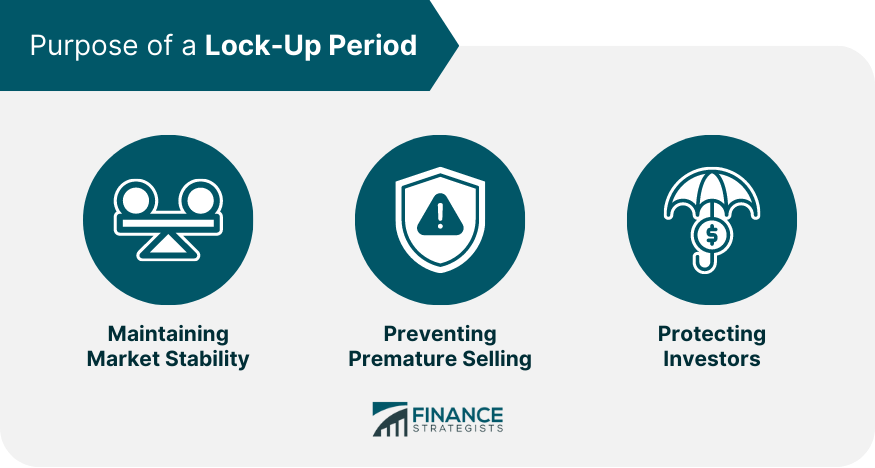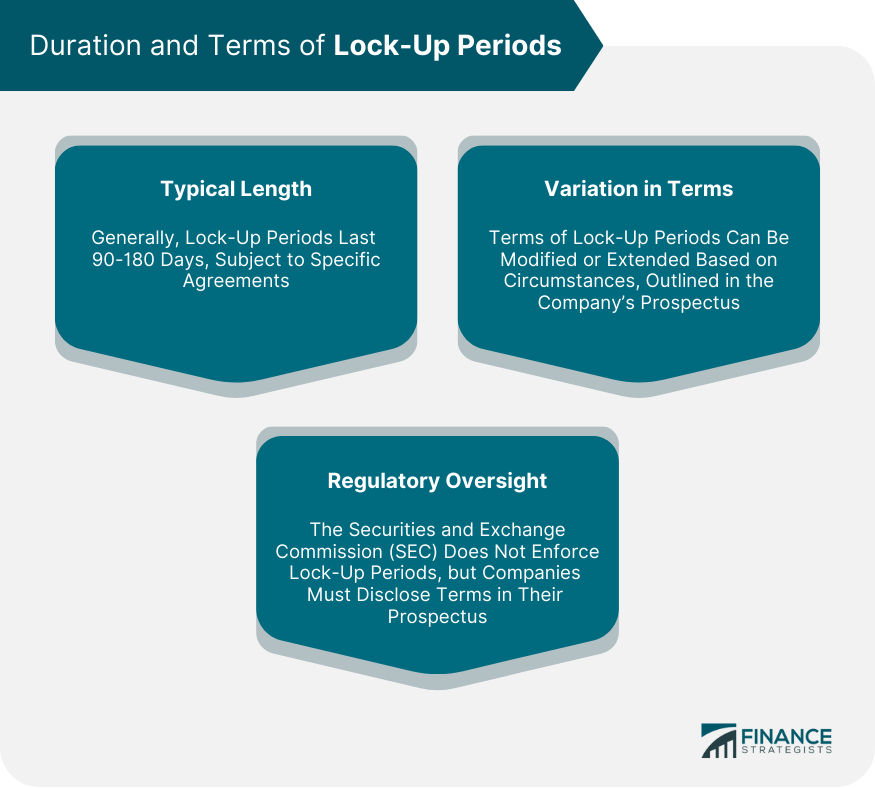A lock-up period in finance is a pre-established timeframe following an Initial Public Offering (IPO) during which major shareholders, such as founders, employees, and early investors, are prohibited from selling their shares. Typically lasting between 90 to 180 days, this period serves a crucial role in maintaining market stability after a company goes public. It provides the company with an opportunity to demonstrate its performance and growth potential free from the downward pressure that a large-scale sell-off might create. Thus, a lock-up period is a key risk management strategy that protects the interests of the company, its new shareholders, and the wider market. There is a multitude of reasons why a company may impose a lock-up period after its IPO. If insiders were allowed to sell their substantial shares immediately after the IPO, it could lead to an oversupply of shares, causing the share price to drop dramatically. Another purpose of the lock-up period is to prevent premature selling that could negatively impact the company’s stock price. It gives the company some breathing space to demonstrate its worth without the potential downward pressure caused by a large-scale sell-off. A lock-up period also provides protection to investors by preventing insiders from immediately profiting at the potential expense of new shareholders. Insiders refer to anyone who owns a significant stake in the company before the IPO and typically include employees, founders, and early investors. They are generally subjected to the lock-up period because their actions could have the most significant impact on the company's stock price. Underwriters are the financial institutions, often investment banks, that help companies go public. They manage the IPO process, determine the initial offering price, and agree on the lock-up period's terms with the issuing company. The duration and terms of lock-up periods can differ depending on the company's agreement with the underwriters. In general, the typical length of a lock-up period ranges from 90 to 180 days. The exact duration, however, depends on the specific agreement between the underwriters and the company. The terms of the lock-up period can vary, with some contracts allowing for the period to be shortened or extended under specific circumstances. These terms are typically detailed in the company's prospectus. Regulatory bodies like the Securities and Exchange Commission (SEC) in the U.S. do not enforce the lock-up period. It is a contractual agreement between the company and the underwriters. However, the SEC requires full disclosure of the terms in the company's prospectum. The lock-up period can have both short-term and long-term impacts on the stock price of a company. In the short term, a lock-up period can help stabilize the stock price by preventing a sudden influx of shares on the market. In the long term, the end of the lock-up period can lead to an increase in stock price volatility due to the potential for a large number of shares to be sold. This effect, however, can be offset if the company demonstrates strong performance and future potential. A study by the University of Florida found that stock prices tend to drop around the expiration of the lock-up period, suggesting that the potential for insider selling can create downward pressure on the stock. The end of the lock-up period can have a significant effect on the company's stock price and trading volume. Once the lock-up period expires, insiders are free to sell their shares. This can lead to an increase in the supply of shares on the market, which, depending on the demand, could depress the stock's price. A significant sell-off can occur if many insiders decide to sell their shares at the end of the lock-up period. Such a scenario often occurs if the company has not performed well during the lock-up period. Prudent insiders and early investors often stagger their sales to prevent a sudden oversupply of shares, which could depress the share price. Exceptions to the lock-up period can be granted in extraordinary circumstances, such as financial hardship. However, these exceptions are not common and must be approved by the underwriters. To obtain a waiver from the lock-up period, insiders must usually submit a request to the underwriters detailing their reasons for needing the waiver. The underwriters then review the request and make a decision. In the U.S., the typical lock-up period is 180 days, although it can be shorter or longer depending on the agreement between the company and the underwriters. The Securities and Exchange Commission requires full disclosure of the lock-up period in the company's prospectus but does not enforce the lock-up period itself. In the European Union, lock-up periods are also common, with a typical duration of 180 days. However, exceptions can be made depending on market conditions and the company's performance. In Asia, the duration of the lock-up period can vary widely. In China, for instance, a lock-up period of one year is standard, while in India, a lock-up period of six months is common. While lock-up periods play a crucial role in ensuring market stability, they have not been free from criticism. Critics argue that lock-up periods represent a form of market manipulation, as they prevent the free sale of shares. They suggest that all shareholders, including insiders, should be allowed to trade freely following an IPO. Critics also point out that lock-up periods can negatively impact small investors. When lock-up periods end, the resulting influx of shares onto the market can lead to a significant drop in share prices, affecting those who purchased the stock during or shortly after the IPO. It is predicted that more flexible lock-up periods may become common in the future, with terms tailored to the specific circumstances of the company and market conditions. Technological advances may also influence the future of lock-up periods. For example, with the rise of blockchain technology, there is the potential for 'smart contracts' to automate the enforcement of lock-up periods. A lock-up period, typically lasting 90 to 180 days post-IPO, provides a crucial buffer to ensure market stability. It controls the selling actions of insiders and allows the company to demonstrate its value in the market. Although not enforced by regulatory bodies, its importance cannot be understated in managing potential stock price fluctuations. However, it's not without criticism, as some argue it manipulates the market and can disadvantage smaller investors. Its impact on stock prices varies, depending largely on company performance and investor strategies. The future may see more tailored lock-up periods, influenced by market conditions, specific company circumstances, and even technological advancements like blockchain. The lock-up period serves as a protective mechanism in the complex and volatile world of finance, underpinning stability in the stock market following an IPO.What Is a Lock-Up Period?
Purpose of a Lock-Up Period
Maintaining Market Stability
Preventing Premature Selling
Protecting Investors

Parties Involved in a Lock-Up Period
Insiders
Underwriters
Duration and Terms of Lock-Up Periods
Typical Length
Variation in Terms
Regulatory Oversight

Effect of Lock-Up Periods on Stock Prices
Short-Term Impact
Long-Term Impact
Empirical Evidence
Expiration of Lock-Up Periods
Effect on the Stock Market
Sell-Off Scenario
Strategies for Insiders and Early Investors
Exceptions and Waivers to Lock-Up Periods
Circumstances for Exceptions
Procedure for Gaining a Waiver
Lock-Up Periods in Different Jurisdictions
United States
European Union
Asia
Controversies and Criticism of Lock-Up Periods
Perceived Market Manipulation
Impact on Small Investors
Future of Lock-Up Periods
Predicted Trends
Impact of Technological Advances
Final Thoughts
Lock-Up Period FAQs
A lock-up period refers to a predetermined time frame following a company's Initial Public Offering (IPO), during which insiders such as founders, employees, and early investors are prohibited from selling their shares. This is to prevent a surplus of shares from flooding the market and causing the stock price to plummet.
The lock-up period is agreed upon by the issuing company and the underwriting firm handling the IPO. The typical duration ranges from 90 to 180 days, although this can vary depending on the specific agreement.
Once a lock-up period ends, insiders are free to sell their shares. This could lead to an increase in the supply of shares on the market and, depending on the demand, could affect the stock price. However, prudent insiders often stagger their sales to prevent a sudden oversupply.
Lock-up periods can be controversial because some view them as a form of market manipulation that prevents the free sale of shares. They can also disadvantage smaller investors if the stock price drops significantly once the lock-up period ends.
Lock-up periods might become more flexible in the future, with terms tailored to specific market conditions and the circumstances of individual companies. Technological advancements like blockchain technology could also influence lock-up periods by enabling the automation of their enforcement through smart contracts.
True Tamplin is a published author, public speaker, CEO of UpDigital, and founder of Finance Strategists.
True is a Certified Educator in Personal Finance (CEPF®), author of The Handy Financial Ratios Guide, a member of the Society for Advancing Business Editing and Writing, contributes to his financial education site, Finance Strategists, and has spoken to various financial communities such as the CFA Institute, as well as university students like his Alma mater, Biola University, where he received a bachelor of science in business and data analytics.
To learn more about True, visit his personal website or view his author profiles on Amazon, Nasdaq and Forbes.















